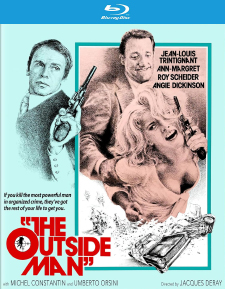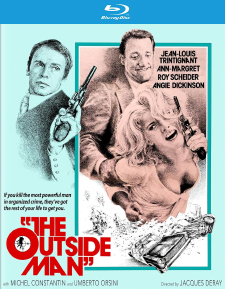Outside Man, The (Blu-ray Review)

Director
Jacques DerayRelease Date(s)
1972 (January 9, 2024)Studio(s)
Cité Films/Les Productions Artistes/United Artists (Kino Lorber Studio Classics)- Film/Program Grade: A-
- Video Grade: A
- Audio Grade: A
- Extras Grade: B-
Review
A very entertaining, unusual thriller, The Outside Man (French title: Un homme est mort, 1972), is a French-Italian co-production primarily in English and apparently filmed entirely in Los Angeles, mostly with American actors like Roy Scheider, Ann-Margret, and Angie Dickinson, though with a French star, Jean-Louis Trintignant, in the leading role.
The director, Jacques Deray, a somewhat underrated auteur, like many of his contemporaries in France, loved American movies, especially film noir. His best remembered movie today is the superb thriller La Piscine (The Swimming Pool, 1969), though his first big international hit was the period French gangster film Borsalino (1970). Both of those films starred Alain Delon, who headlined many of Deray’s films, though both Trintignant and Jean-Paul Belmondo also did multiple films for the director.
One story, maybe apocryphal, was that Deray and his French crew were all set to make a film in Los Angeles that was abruptly canceled, and hurriedly threw together the script for The Outside Man to replace it before their visas expired. That seems unlikely but not impossible. Kino’s new Blu-ray release offers both the French and English-language international release (different from the U.S. theatrical release) versions of the film, on separate discs. Since the film is set in Los Angeles with Americans (and Trintignant) speaking English 95% of the time, I opted to watch the English-language version.
Lucien Bellon (Trintignant) arrives in Los Angeles, checks into a hotel, and in a rented car drives to Beverly Hills, to a mansion where he’s let in through its imposing front gate. Inside, he shoots dead its owner, rich mobster Victor Kovacs (Ted de Corsia, in his last film role). As he flees, Bellon is spotted by the Kovacs’s wife, Jackie (Angie Dickinson), and son, Alex (Umberto Orsini, his voice clearly dubbed), but later to the police they mysteriously provide an absurdly inaccurate description of the well-dressed Frenchman.
Bellon returns to his hotel surprised to learn he’s been checked out of his room and soon has hitman Lenny (Roy Scheider) on his tail taking potshots at him. Clearly, Jackie and Alex hired this torpedo from Detroit to cover their tracks with the mob after hiring Bellon to kill Kovacs.
After holding a young mother, Mrs. Barnes (Georgia Engel, Georgette from The Mary Tyler Moore Show!) and her son (Jackie Earle Haley!) hostage for a time, Bellon locates waitress Nancy Robson (Ann-Margret), a “friend of a friend,” who sets him up with a boyfriend who can forge a French passport, thus enabling Bellon to return to France. But Lenny is still close behind, and their frequent chases and shootouts all over L.A. attract the attention of LAPD detective Anderson (Felice Orlandi), he suspicious over the circumstances of Kovacs’s murder.
The clever film is primarily visual, bereft of long conversations—Bellon is especially circumspect—and nearly all of those conversations are in English, with very little French. (Trintignant speaks thickly-accent English that’s occasionally difficult to understand; given what we learn about the character later in the story, a better English-speaker like Michel Piccoli might have been a wiser casting choice, though Trintignant is excellent.)
Being primarily French-made, The Outside Man has a particularly fascinating take on Los Angeles as a disorienting sprawl of vulgar topless bars, Orange Julius stands, burlesque houses, a roller derby, prostitutes, a disparity of great wealth and poverty. There’s a big scene at the ruins of the Venice Pier amusement park, a drive-in, and Kovacs’s mansion reportedly was leased to the production by none other than James Bond producer Albert R. “Cubby” Broccoli.
When Bellon invades Mrs. Barnes apartment, her son is watching a rerun of Star Trek. At various times we see televisions seemingly tuned in to real broadcasts, unusual for that time. (One channel airs a scratched-to-hell 16 mm print of some Western.) Georgia Engel hadn’t yet appeared as Ted Baxter’s ditzy girlfriend on Mary Tyler Moore, but Deray clearly recognized her uniquely flighty screen persona. Wide-eyed from the home invasion, she delights in telling her story before the TV news cameras. Indeed, the entire film has a slightly satirical tone in its depiction of Angelinos; a nude dancer friend of Nancy’s (Playboy Playmate Connie Kreski), head-to-toe in ghostly white makeup, casually guides her and Bellon through a dark alley while completely nude. The big climax has Kovacs’s corpse posed seated, holding a cigar in one hand as if holding court. In an early scene, Bellon is trying to find downtown L.A. in his rental car, and after first seeking help from an oddly threatening-friendly biker gang he picks up a hippie hitchhiker who turns out to be an ex-drug user-turned-aggressive-Jesus freak who gets caught in the crossfire. At times it’s as if Bellon were on some strange alien world. Paired with Jacques Demy’s similarly-toned Model Shop (1969), the two films would make a great double-feature.
Deray’s love of film noir is apparent in his use of actor de Corsia, gangster specialists like Alex Rocco, and Venice locations from Welles’s Touch of Evil. Scheider, or course, was coming off The French Connection and had recently appeared with Trintignant in The Assassination, a political thriller directed by Yves Boisset, but I also suspect Deray may have noticed Scheider’s resemblance to French star Lino Ventura as Ventura looked in the late-1950s, when he was typecast as hitmen. I wouldn’t be surprised to learn that Quentin Tarantino lifted Michel Legrand’s jazzy score for use in one of his own films; it’s like a great soundtrack for a blaxploitation film.
Kino’s release of The Outside Man impresses but begs a few questions. The English-language version does not subtitle any of the French dialogue. There’s probably less than two minutes-worth in the entire film, and even non-speakers can probably get the gist of what’s being said. Some viewers old enough to have seen the original theatrical run insist there were subtitles on those prints, others say there were not. The international release is formatted for 1.85:1 widescreen while the French release is 1.66:1. That’s splitting hairs but seems odd; European films shot 1.66:1 were certainly still being released that way in the U.S., so why slightly crop it more? The two cuts are virtually identical, the international cut running about one minute longer. About seven minutes were cut for the version eventually released in the U.S., but that’s not what’s included here.
Some reviews of these 4K transfers by Gaumont are unduly harsh, but to my eyes the film’s visual design isn’t obviously altered or tampered with; it looks very much like an early-1970s French film shot in the U.S. Apparently on at least one variation of this release there was a title song performed by Joe Morton that may have been cut (possibly replaced by a Legrand cue) for legal reasons; one reviewer was so upset by this—he mentions it three times in his review—that, for him, it ruined the Blu-ray. I have no such deal-breaker complaints; to me, it looks fine. Both versions have decent DTS-HD Master Audio (2.0 mono), also fine, with optional English subtitles. The discs are Region “A” encoded.
Extras include trailers for both releases, and a new audio commentary with Howard S. Berger, Steve Mitchell, and Nathaniel Thompson.
The Outside Man is a fascinating little thriller. It’s not up to the level of director Deray’s best films but, boy, is it entertaining.
- Stuart Galbraith IV

